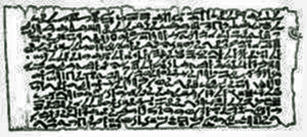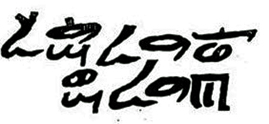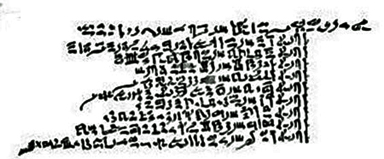The Egyptian Alphabetical Form Of Writing
1. Remote Age Of Egyptian Alphabets
Most modern Western scholars affirm, explicitly and implicitly, that the Ancient Egyptian alphabet (and language) is the oldest source in the world. In his book The Literature of the Ancient Egyptians [page xxxiv-v], the German Egyptologist Adolf Erman admits:
“The Egyptians alone were destined to adopt a remarkable method, following which they attained to the highest form of writing, the alphabet. . .”
The British Egyptologist, W.M. Flinders Petrie, in his book The Formation of the Alphabets [page 3], concluded:
“From the beginning of the prehistoric ages, a cursive system consisting of linear signs, full of variety and distinction was certainly used in Egypt.”
The most eminent authority on languages, Isaac Taylor, in his book History of the Alphabets, Volume 1, page 62:
“The immensely early date at which symbols of an alphabetic nature are found on the Egyptian monuments is a fact of great interest and importance. It is of great interest, inasmuch as it constitutes the starting point in the history of the Alphabet, establishing the literal truth of the assertion that the letters of the alphabet are older than the pyramids—older probably than any other existing monument of human civilization.”
Isaac Taylor, in his book History of the Alphabets Volume I, pg. 64, wrote about the Egyptian King Sent:
“King Sent, in whose reign the alphabetic characters were already in use, may be taken to have lived between 4000 and 4700 BCE. Startling as the result of such calculations may appear, it must be affirmed to be probable that the beginnings of the graphic art in the valley of the Nile must be relegated to a date of seven or eight thousand years from the present time.“
It is very clear that the Ancient Egyptian alphabetical language was the FIRST in the world thousands of years prior the much-to-do-about nothing “Sinai scripts” [see a later chapter about this topic].
In his book The Formation of the Alphabet, W.M. Flinders Petrie has collected and tabulated alphabetical letterforms that extended from the early prehistoric age of Egypt to the Greek and Roman eras. Petrie also compiled (from several independent scholars) similar-looking alphabetical letter-forms from 25 locations in Asia Minor, Greece, Italy, Spain, and other locations throughout Europe. All are much younger than the Ancient Egyptian alphabetical letter-forms.
Petrie’s tabulation of these alphabetical letter-forms shows that:
1. All alphabetical letter-forms were present in Ancient Egypt since early pre-dynastic eras (over 7,000 years ago), prior to any place else in the world.
2. All the Egyptian alphabetical letter-forms are clearly distinguishable in the oldest recovered so-called Egyptian “hieratic writing” more than 5,000 years ago.
3. The same exact Ancient Egyptian alphabetical letter-forms were later adopted and spread to other people throughout the world.
2. The Distinctive Pre-Hyksos Egyptian Alphabetical Papyri
The eminent German Egyptologist Adolf Erman wrote, in his book Life in Ancient Egypt, page 339:
“Even under the Old Kingdom [2575-2040 BCE] a special cursive hand had already been invented for daily use, the so-called hieratic.”
Isaac Taylor, in his book The History of the Alphabet, Vol.1, pages 94 and 95, referred to three important Ancient Egyptian manuscripts from the Old and Middle Kingdom eras [2575-1783] prior to the Hyksos period [c.1600 BCE], which had very clear and distinctive alphabetical cursive scripts. The three papyri agree essentially with each other as to the general style of the writing and the forms of the individual alphabetical characters in neat cursive.
These early alphabetical writings [Hieratic] clearly show a true cursive character: black, rounded, and bold.
The three Ancient Egyptian manuscripts referred to by
Isaac Taylor are:
1. An Egyptian manuscript in the possession of Prof. Lepsius in which mention is made of the builder of the Great Pyramid of Giza, Khufu [Cheops], and other kings of the earlier dynasties of Memphis [2649 -2465 BCE].
2. The most perfect specimen of the alphabetical neat cursive writing of the early period is the celebrated papyrus which was acquired at Thebes by M. Prisse d’Avennes, given by him to the Bibliotheque Nationale at Paris. This manuscript is usually called the “Papyrus Prisse.” It was published in facsimile by M. Prisse in 1847, and consists of eighteen pages of a magnificent alphabetical cursive writing, unequaled in size and beauty, the characters being unusually large, full, and firm. A statement at the end of the papyrus shows that it is only a copy of the original work, which purports to have been composed by Prince Ptah-Hotep, who lived during the reign of Assa, a king of the fifth dynasty [2465-2323 BCE].
3. In the Museum at Berlin, there are some fragments of a Hieratic papyrus during the times of the Egyptian kings Amenemhat and Usurtasen, who belonged to the twelfth dynasty [1991-1783] which preceded the invasion of the Hyksos.
Here is the Facsimile of papyrus Prisse, where letter-forms look exactly like letter-forms throughout the recognized Ancient Egyptian history and beyond.
1. Clear alphabets from the Old Kingdom era [2575-2040 BCE] from a letter from a widow, written on linen, Egyptian Museum, Cairo, JE25975.
2. This is the third of a cycle of five hymns to Senwosret III, which was found in the town of el-Lahun. The hymn to Senwosret III shows the strophic arrangement, and was written in mid 12th Dynasty [1991-1783 BCE].
3. The writing shown here is a memorandum from the Overseer of the temple to the Lector priest at Nubkaura Temple at el-Lahun (during the time of Senwosret II, 1897–1878 BCE), notifying him that Sirius would rise on the 16th day of the 4th month, so as to take note of its exact location and time to enter it into the temple records.
4. Several other similar samples on various topics and purposes can be found in R.B. Parkinson’s book [see Selected Bibliography.]
5. Other Ancient Egyptian papyri with neat alphabetical writings on all kinds of subjects from this very early era are referred to throughout various publications by Moustafa Gadalla and are in most Egyptological references.
3. Smoke Screening Thousands Of Egyptian Alphabetical Writings
The BIGGEST smoke screen in history is concealing the (Ancient) Egyptian alphabetical writing system. They made everyone think of the Egyptian language as a collection of “primitive pictures” called hieroglyphics. They concealed the Egyptian alphabetical system as the MOTHER of ALL languages in the world.
Here is how Alan Gardiner, in his book Egyptian Grammar, tries to “rationalize” how they concealed the Egyptian alphabetical system:
“Egyptologists have experienced the practical need of adopting some common standard to which different hieratic hands could be reduced, and instead of selecting one simple style of hieratic for the purpose, have preferred to transcribe all hieratic hands into hieroglyphic”.
Gardiner’s “explanation/justification” for burying alphabetical [hieratic] writings assures us that there were various forms of writings for various purposes. The very same Western academies NEVER used the same “lame excuse” with Greek, Roman, or any other language in the world!
This lame excuse was ONLY used in Egyptian writings to deceive and conceal the Ancient Egyptian’s alphabetical writing language.
There is NOT A SINGLE reference—prior to this 19th-20th century “Western Egyptologists” conspiracy—that stated a relationship between hieroglyphics (pictorial signs) and Hieratic/demotic alphabetical letter-forms. On the contrary, EVERY single reference stated EXPLICITLY how unrelated they are.
4. Egyptian Is Dead, Long Live “Arabic”
After concealing the (Ancient) Egyptian alphabetical writing system that makes everyone thinks of the Egyptian language as a collection of “primitive pictures” called hieroglyphics, their second blow was declaring that the Ancient Egyptian language is DEAD and that it was replaced—out of thin air—by the “Arabic” language!
To say that Egyptians speak “Arabic” is totally false and illogical. It is the other way around: the “Arabs” long ago “adopted” and continue to speak EGYPTIAN.
The British Egyptologist Alan Gardiner in his book, Egyptian Grammar, page 3, writes:
“The entire vocalic system of Old Egyptian may indeed be proved to have reached a stage resembling that of Hebrew or modern Arabic”
Egyptian is the mother of all Semitic languages, as proven and concluded by ALL academicians.
As for other pillars of a language such as grammar, syntax, etc., it remains exactly like the Ancient Egyptian language.
The British Egyptologist Alan Gardiner, in his book Egyptian Grammar, page 2, stated:
“The Egyptian language is related, not only to the Semitic tongues (Hebrew, Arabic, Aramaic, Babylonian, etc.), but also to the East African languages (Galla, Somali, etc.) and the Berber idioms of North Africa. Its connection with the latter groups, together known as the Hamitic family, is a very thorny subject, but the relationship to the Semitic tongues can be fairly accurately defined. In general structure the similarity is very great; Egyptian shares the principal peculiarity of Semitic in that its word-stems consist of combinations of consonants, as a rule three in number, which are theoretically at least unchangeable. Grammatical inflection and minor variations of meaning are contrived mainly by ringing the changes on the internal vowels, though affixed endings also are used for the same purpose.
The “Arabic Language” complies exactly with the all linguistic characteristics of the much older Ancient Egyptian language which was detailed in Chapter 15 of this book. Such include (but are not limited to) Ancient Egyptian prototypal interconnected lexicon, grammar, and syntax such as the significance of verbs, verb roots, verb stems,, verb classes and structures, the conjugation scheme for verbs, and Egyptian prototypal etymology/lexicons and word formation/derivations from a three-letter root (which signifies a certain general concept) into numerous patterns through the use of intermediate vowels and prefixes, infixes and suffixes, etc.; in addition to types and structures of syllables as well as syntax/word orders and sentence types.
[Excerpts from Ancient Egyptian Universal Writing Modes by Moustafa Gadalla]
https://egyptianwisdomcenter.org/product/ancient-egyptian-universal-writing-modes/
https://egyptianwisdomcenter.org/product/ancient-egyptian-universal-writing-modes/





